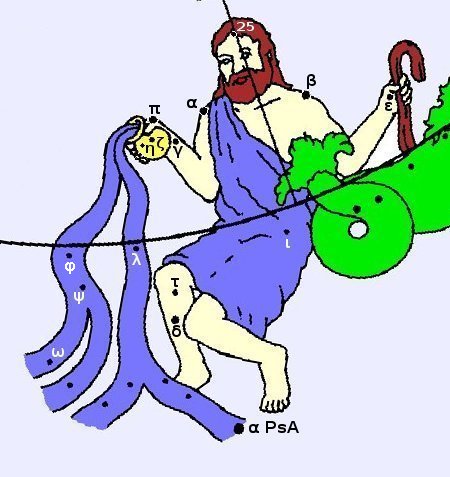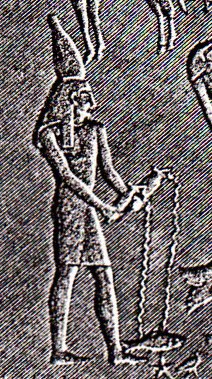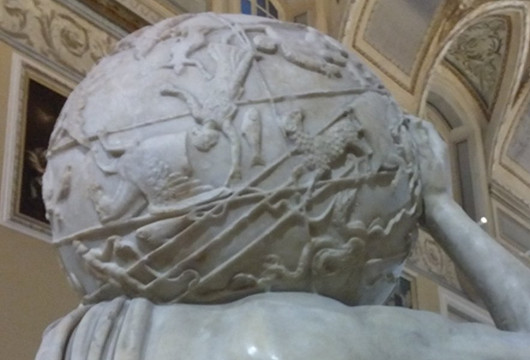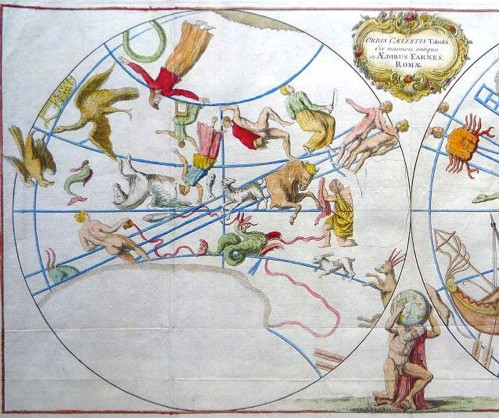
by John P. Pratt
Sat 9 Jan 2016, 1 Eagle (SR)
©2016 by John P. Pratt. All rights Reserved.
| 1. Aratus Describes Aquarius |
| 2. Stars Deleted From Aquarius |
| 3. Suggested Interpretation |
| 4. Conclusion |
| 5. Addendum |
| Notes |
The origin of the star figures which are called constellations date back nearly 5,000 years. Most ancient peoples said they had an inspired origin. Accordingly, they tried to carefully preserve the figures and myths that became associated with them. The tradition which seems most accurate to me is that the constellations were revealed to the prophet Enoch. That seems credible because they seem clearly to tell the story of gospel of Jesus Christ.[1] This article is being published on the day 1 Eagle of the Sacred Round in honor of Enoch's proposed birthday on that day.[2]
Because of the sacredness of the original constellations, it seems extremely important to attempt to restore the constellations to their original form.[3] Some of my earlier articles have attempted to do that, such as restoring the lost constellation of the Infant Prince.[4]
 |
Ptolemy explicitly states that he modified the locations of the positions of some stars in the figures to suit his ideas of where the stars should be. He was mostly just updating the work of an earlier Greek astronomer named Hipparchus and he claimed Hipparchus did the same thing. In his star catalog, he lists stars nearby each of the constellations which are not included in the figure. Sometimes his adjustments seem ludicrous. For example, he admits to taking the brightest star in Aries (the Ram) right out of the constellation even though he says Hipparchus included it in the muzzle. Moreover, Arcturus, the brightest star in the northern skies, is removed entirely from its constellation of Bootes (the Herdsman).[5] Aratus had stated that Arcturus was located just below his belt.
There is another propensity which continues with astronomers to this very day. They are more interested in a star map than preserving ancient religious symbolism. They do not like the idea that a single star might be located in two constellations. Today that is just not allowed; each star is considered to be part of exactly one constellation. The brighter stars are given a letter or number designation as part of that constellation.
Another undesirable feature to astronomers concerning the twelve constellations of the zodiac, through which the sun, moon, and planets appear to move, is that the constellations overlap each other. It is clear that in some cases constellations were either shortened or entirely removed because of this overlap. A good example is the constellation of Libra (the Balance) which was held in the claws of Scorpio (the Scorpion). The Greeks lost that constellation entirely and saw only the Claws of the Scorpion.
When one looks carefully at the stars listed by Ptolemy as outside of the figure, it becomes clear that he was not just randomly listing the brighter stars in the area. About half of the constellations show no extra stars in the area which is just not true. It gradually becomes clear that most of the stars listed as outside of the constellation were in fact previously in the constellation and were removed. For example, in the case of Bootes there is only one star listed as nearby and it is Arcturus which clearly used to be in the constellation. Several of the stars listed as nearby the Scorpion are those between its claws which formed part of Libra.
Figure 1 shows the constellation of Aquarius as described by Ptolemy, using modern star designations. The black curved line is the ecliptic, the apparent path of the sun through the constellations. Figure 1 is an actual star map. It shows the precise locations of the stars Ptolemy included in his description of the constellation. The numbers or little Greek letters are the modern star designations, which are followed by the three-letter abbreviation of the constellation. For example, the star in the left hand of Aquarius is called ε Aqr (epsilon Aquarii). It is just a way to specify a star.
Those examples seem to authorize research into what other constellations might have looked like before Ptolemy's time. In this article let us begin by looking at the constellation of Aquarius.
The illustration in Figure 1 was drawn to my specification many decades ago. Ptolemy did not describe two specific streams emerging from the jar held by Aquarius. In fact, he did not even mention the jar. It was drawn with two streams because of the other ancient descriptions. One such is the Egyptian figure of Aquarius from the Planisphere of Dendera at the temple of Hathor, which clearly show two streams (see Figure 2). The reason for this paper is that just last week when I reread the description by Aratus in his Phaenomena of two streams it was clear that he was describing a stream much longer than Ptolemy described.
The name "Aquarius" is Latin; the Greek name was "Hydrochous". With that in mind, here is the description from Aratus of the water and streams being poured out by Hydrochous:
Other stars, sparsely set beneath Hydrochous, hang on high between Cetus in the heavens and the Fish, dim and nameless, and near them on the right hand of bright Hydrochous, like some sprinkled drops of water lightly shed on this side and on that, other stars wheel bright-eyed though weak. But among them are borne two of more lustrous form, not far apart and yet not near: one beneath both feet of Hydrochous, a goodly star and bright, the other beneath the tail of dark-blue Cetus. This cluster as a whole men call The Water.[6]
 |
The constellation as shown by Ptolemy clearly agrees with Aratus concerning the star which ends the water stream on the right. Looking at Figure 1, below the feet of Aquarius is a bright (first magnitude) star just as Aratus described. It is named Fomalhaut and is designated α PsA (alpha PsA), being in Piscis Austrinus (PsA) (the Southern Fish). It is known as one of the four corners of the earth or sometimes the four corners of heaven. Ptolemy lists that star as both being the last star of the right hand stream and also being in the head of the Southern Fish. Figure 1 does not show the fish because it is just focusing on Aquarius.
Again looking at Figure 1, the left stream ends in the star ω Aqr (omega Aqr). That is neither a bright star nor anywhere near being under the tail of Cetus. That is a huge clue that someone cut off part of that left-hand stream.
Now let us return to the star catalog of Ptolemy. There are only three stars listed as near Aquarius. They form a small triangle of three dim stars (fourth to fifth magnitude). The modern designations are 2 Cet, 6 Cet, and 7 Cet (they are now considered as part of Cetus). They are all near each other in the direction of extending the stream in Figure 1, shown ending in ω Aqr. From what was learned by studying all of the stars listed as near constellations in Ptolemy's star catalog, these three stars are excellent candidates to have been deleted from the left stream of Aquarius. The three stars are shown circled in blue in Figure 3. The stars designated at the tip of the upper and lower lobes of the Sea Monster's tail are also indicated. The lower one is named Diphda. The artist took considerable liberties by changing the location of the tail and including the three circled stars which Ptolemy stated were between Cetus and Aquarius. Thus we see how over time those stars migrated from Aquarius to Cetus.
 |
If we continue the left stream through those three encircled stars, we come the the very brightest star in the constellation of Cetus: Diphda, designated β Cet (beta Cet). Ptolemy lists it as the southern tip of the tail of Cetus. It seems clearly to be the bright star Aratus described as ending the left stream because there is no other in the vicinity. It is also called Deneb Kaitos, meaning "tail of the whale". The tail of the Sea Monster as described by Ptolemy ends in two points (bilobed) like most fish. Diphda is the star at the very tip of the southern lobe of the tail. The star at the tip of the top tail lobe is also indicated in Figure 3.
It is here proposed that Diphda is the original ending of the left stream of Aquarius. As further evidence of an ancient connection between Diphda and Fomalhaut as the ends of the two streams, the old indigenous Arabic name "Diphda" means "Frog", being a shortened form of "Second Frog". The star Fomalhaut was known as the "First Frog".[7] Thus, the two stars were related to each other in the view of ancient Arabs.
 |
It is well known that the fish was an ancient symbol for a church. Two LDS revelations have been quoted in my earlier articles as directly referring to the symbolism of Aquarius pouring out water onto the head of the Southern Fish. The following three paragraphs and the illustration of Aquarius and its caption are quoted directly from one article.[8]
As well might man stretch forth his puny arm to stop the Missouri river in its decreed course, or to turn it upstream, as to hinder the Almighty from pouring down knowledge from heaven upon the heads of the Latter-day saints. — D&C 121:33
 |
There is another witness in the Doctrine and Covenants that the Lord uses the symbolism of pouring out living water on the heads of the saints to represents the true teachings of the Savior. When priesthood keys were restored in the Kirtland temple, the Lord said it would be the beginning of "the blessing which shall be poured out upon the heads of my people" (D&C 110:10, compare 3 Nephi 10:18). Here we have the same symbolism of pouring on the head, but what does it mean? There were three sets of keys restored at that time: of the gathering of Israel, of the dispensation of the gospel of Abraham, and of temple work. All three of these could be part of the blessing to be "poured out", because the living water could refer both to knowledge of the gospel and also to temple blessings.
All of those earlier interpretations still seem accurate for the right-hand stream, but what about the proposed left-hand stream? It too ends on a fish-like creature. There are a few obvious differences between them which may give us a clue to their interpretation. The right-hand fish is small and all of the stars except Fomalhaut are rather obscure. That obscurity may relate to the true church always being rather obscure in the world.
On the other (left) hand, the left stream hits the tail, rather than the head, of the fish-like Sea Monster. It is a huge, ugly, terrifying predator, not obscure in any way. So what does it represent?
Considering synonyms for the "huge and terrible fish", the possibility arises that the Sea Monster might represent the "great and abominable church". Let's explore that possibility. One thing favoring that interpretation is the parallel symbolism that both creatures represent churches.
 |
Before continuing, let us note that in an earlier paper the Sea Monster was identified as the great monster "Death" (2 Nephi 9:10), attached to which are two bands securing the two fishes of Pisces (the Fishes). Aries (the Ram) is extending his right foreleg across the bands, apparently breaking the Bands of Death (see Figure 4).[9]
The constellations have many layers of meanings, just as do the scriptures. Sometimes those meanings are opposites, such as Scorpio (the Scorpion) sometimes representing Satan with the sting of death or Christ as the Judge. It is entirely possible that there are multiple layers of meaning to the triad of the Ram, the Fishes, and the Sea Monster. So we are at liberty to pursue a new interpretation without discarding former understanding.
If the Sea Monster represents the Great and Abominable Church of the Devil, and the Southern Fish the Church of the Lamb, then how would that tie to the Fishes of Pisces and the Ram?
It has recently been suggested that an older or alternate form of the Bands holding the two fishes of Pisces might have been a net to catch them.[10] Presumably the Bands would form two edges of the Net which are tied in a knot at the corner. Even without the support of ancient sources, that proposal may have merit because there are indeed several stars between the bands which could serve as knots for the Net. The net symbolism might fit well with the interpretation of the Sea Monster as the Great an Abominable Church for the following reasons.
The Ram, representing Christ (the Lamb), with his foreleg extending to the Net, could be throwing it out to catch fish for the Kingdom of God. Jesus told his apostles He would make them fishers of men (Matthew 4:19). Let's review the parable where He provides more details of the net symbolism:
Again, the kingdom of heaven is like unto a net, that was cast into the sea, and gathered of every kind:
Which, when it was full, they drew to shore, and sat down, and gathered the good into vessels, but cast the bad away.
So shall it be at the end of the world: the angels shall come forth, and sever the wicked from among the just,
And shall cast them into the furnace of fire: there shall be wailing and gnashing of teeth. —(Mat 13:47-50)
Apparently the net in the parable represents the formal institution of the Church of Christ, whereas the fish in the net represent the church members, who are called simply the church. Note that members of the church institution founded by the Savior are not all home free just for joining (being baptized). The parable shows that both good and bad fish are caught in the net and that at the last day the angels will decide which are which. That is consistent with all of the teachings of the scriptures that we must endure to the end to be saved (2 Nephi 31:16).
 |
One possible interpretation of the two fish in the Net is again the two-fold symbolism of two kinds of fish, good and bad. The Northern Fish (the one facing upward) of Pisces appears to be above the Net, and could represent the ones being gathered out of the net by the angels. It is pointing up to the angelic region of the heavens. The Western Fish could represent the bad fish. It appears to be either in the Net or being cast away, depending how the Net is drawn.
But what has all of this to do with the Sea Monster, to which the Net is apparently attached? Aratus states that the star at the knot of the two bands is the same as one on the back of the neck of the Sea Monster.
One of the main themes of the Bible and Book of Mormon is that the Lord has repeatedly needed to restore his Church to the earth in what are sometimes called dispensations. Throughout the ages, His church has apparently been given to Adam, to Enoch, to Noah, to the Jaredites, to Melchizedek, to Abraham, to Moses, to Lehi, to Peter, and to Joseph Smith. In all of those cases except the last, which is still in process, the religions generally end up in one of two ways. On the one hand, sometimes the institution helps the people to become more and more righteous until the members are gathered by angels when they die or are translated. Apparently both Enoch and Melchizedek had the happy result of having their entire cities be translated into heaven.
The other more common result is that the institution, even though set up by a true prophet, later begins to degenerate into apostasy and gradually morphs into a wholly-owned subsidiary of the Great and Abominable Church. For example, the church headed by Peter became the Catholic Church. Reformers noticed that it no longer was the original Church of Christ, so they formed the Protestant churches. Later the Lord told Joseph Smith that all of the creeds of all churches were "an abomination" (there's that word again!) in His sight (JSH 1:19), so apparently even the Protestant churches had also joined the great and abominable institution. The Prophet Joseph was then instructed to again restore the Lord's true church.
 |
There is another important question to consider. Why do both streams come from the same jar? The Egyptians represented the two streams as coming from different hands of Aquarius. That makes perfect sense with the right-hand and left-hand symbolism. That is, the right stream could symbolize blessings of the righteous and the left stream cursings of the wicked. The Egyptians usually emphasized symbolism in their drawings of the constellations rather than accuracy in representing the figures. It is very fortunate that they did because it really helps the meanings become more clear.
If the right stream is blessings for the righteous and the left is cursings for the wicked, why do both come from the same jar? Is God the author of both?
Not only do the scriptures make it clear that God is the author of both blessings and cursings, they also pinpoint the source of that dualism to be covenants to keep the Lord's commandments. The jar in the right hand of Aquarius seems to represent a covenant offered and accepted by His church. If the covenant is kept then great blessings follow; if the covenant is broken then cursings result. An excellent example is found in the law of Moses, which was a covenant between God and the children of Israel. Great blessings are explicitly enumerated for obedience and cursings for disobedience. It might be interesting to note that there are 12 verses promising blessings (Deut. 28:2-13) and 31 listing cursings (Deut. 28:15-45). The point here is that both the blessings and the cursings come from the same law, predicated on obedience or disobedience. That fits perfectly with both streams flowing from the same covenant jar. In modern times the Lord has followed this same pattern of associating both blessings and cursings with obeying His commandments (D&C 124:48).
Note also the difference between disobeying God's will and breaking a covenant. All are born with the light of Christ and will be judged by whether they followed it (D&C 93:32). All can know God's will in that sense. But God also offers mankind covenants, often symbolized by an ordinance such as baptism, in which they promise to keep His commandments. Breaking a covenant is more serious than simply ignoring one's conscience. Something that tipped off the Reformers that the Catholic Church was off track was that it had changed the ordinance of baptism from immersion to sprinkling (baptize is the Greek word for immerse). It is probably the keeping or breaking of a covenant which the streams of blessings or cursings symbolize.
Consider an archetypal example of how Satan can convert someone to his church. Adam was commanded to sacrifice a lamb in similitude of the Lamb of God. Abel obeyed that ordinance, but Satan told Cain to modify the offering that he made to the Lord: offer the firstfruits from his garden just as Abel had offered the firstlings of his flock. The Lord rejected that offering and cursed Cain, exactly as Satan knew the Lord was required to do when a covenant is broken. The main point here is that Satan began by commanding Cain to worship the Lord (Moses 5:18), but in a corrupted manner. Satan did not start out telling Cain to commit evil acts. After Cain felt rejected by God, he then turned fully to serve Satan. The fall of Cain involved modifying an ordinance. Thus we see that right from the beginning, Adam's own son, who started out to make an offering according to an ordinance of the Church of the Lamb, was snatched by Satan while still in the Net and pulled down to become a founding member of the Great and Abominable Church!
This article began as a simple exercise in attempting to restore four stars to the constellation of Aquarius, but has resulted in discovering rich symbolism to remind all of us of the importance of keeping our covenants with God. As we contemplate the autumn night sky, may the two streams of Aquarius remind us of the blessings and cursings which can result from covenanting to keep the commandments of God.
It is concluded that four stars were removed from the constellation Aquarius by the Greeks sometime after Aratus (250 BC) and before the creation of Ptolemy's star catalog (AD 150). All four of those stars are listed in his catalog, but apparently someone felt that the left stream of water being poured from the jar of Aquarius was unnecessarily long, so the ending stars were simply deleted from the constellation. Today all four stars are considered to be in the area of sky associated with Cetus (the Sea Monster) and are usually shown as part of that constellation.
The symbolism of this newly restored left stream might well be that it represents cursings on the Great and Abominable Church, represented by the Sea Monster (Cetus). As shown in earlier articles, the right stream represents blessings being poured out on the head of the Church of the Lamb. Both streams emerge from the same jar, most likely representing a covenant with God.
 |
In the illustration in Figure 6 of that star sphere, looking carefully near the bottom there is a stream seen issuing from the jar of Aquarius ending at the tail of the Sea Monster! On a sphere, all of the constellations are backwards because we are outside of the sky sphere looking in, rather than our usual view from the earth looking out. It can be seen more clearly near the bottom left in Figure 7, where the entire Farense sphere has been drawn on a plane. It appears that the usual stream going to the Southern Fish was omitted because that fish is hidden. This is the first confirmation known to me that the stream was restored correctly in this article as ending at the tail of the Sea Monster!
 |